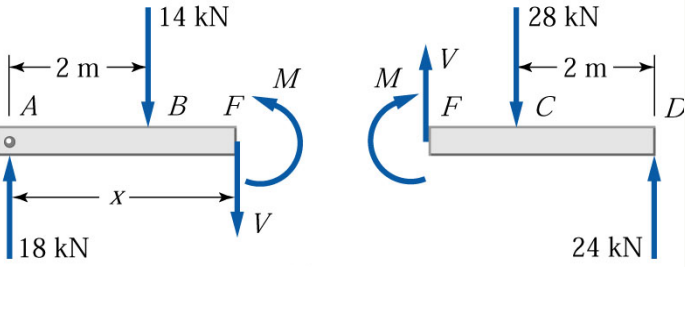As the name of the subject, "Statics", suggests, the beam and every piece of the segment (AF & FD), that is imaginarily separated from the beam, must stay static in its own system. In structural terms, it means the beam and the segments must remain in "structural equilibrium", either in the global scene/system, or the local scene/system, the equilibrium requirement is satisfied when $\sum F_x = 0$, $\sum F_y = 0$, and $\sum M = 0$.
Before get to answer your question, we need to designate the positive direction of forces with respect to the Cartesian Coordinate System (x, y, and z axes). Commonly, a force is positive in the same direction as "x" and "y" axes (arrow pointing up and right respectively); the moment is positive when rotate counter-clock-wise (CCW) about the "z" axis.
Now let's first check the beam to see whether it is in the state of equilibrium. THe answer is "yes" (see the top figure on the sketch below).

Next, let's break the beam at point "F" (the bottom figure). Note that I've placed all the internal forces on both sides of joint "F" in the positive direction.
- Now let's write the equilibrium equations for the left segment,
$\sum F_x = 0, -14 + 18 + V_L = 0$, then solving
$V_L = 14 - 18 = -4$, here the minus sign indicates the force is pointing down rather than the direction drawn (up), so it needs to be corrected on the sketch to maintain balance.
$\sum M_A = 0, -14*2 + (-4)*3.5 + M_L = 0$, solving
$M_L = 28 + 14 = +42$, the positive sign indicates the result is in agrement with the direction shown on the sketch (CCW).
- Similarly, let's write the equilibrium equations for the right segment,
$\sum F_x = 0, -28 + 24 + V_R = 0$, then solving
$V_R = 28 - 24 = +4$, the direction of the force drawn is correct (up).
$\sum M_D = 0, -28*2 + 4*3.5 + M_R = 0$, solving
$M_R = 56 - 14 = +42, $M_L$ rotates CCW, the direction drawn is incorrect.
Next, let's summarize the internal forces with their corrected directions:

Note, the directions of the forces are in agreement with the sketch you've provided. Now you should know what is the governing factor, and its importance, - "structural equilibrium requirement".
Final (sanity) Checks -
Left Segment:
$\sum F_y = -14 + 18 -4 = 0$
$\sum M_A = -14*2 - 4*3.5 + 42 = 0$
Right Segment:
$\sum F_y = -28 +4 -24 = 0$
$\sum M_D = -28*2 + 4*3.5 +42 = 0$
Done.


